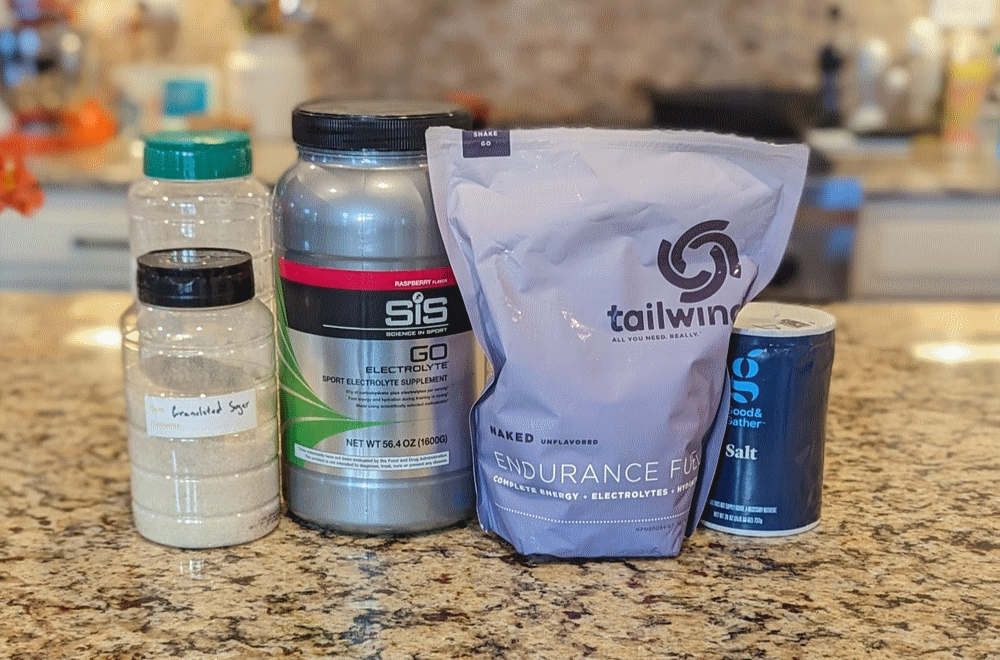About a year ago, a friend sent me an article with some really interesting claims around Mathieu van der Poel’s (MVP) race day nutrition plan. I didn’t put any effort into it at the time. Just assumed that it was just another one of those super-human things that MVP can do, that the rest of us can’t. I was wrong. We’ve been fed a lie about endurance fueling.
OK, so maybe “lie” is a bit hyperbolic, but “best information available at one time, that we used to believe, never bothered to update in a broader context, so it’s constantly repeated, making it one of those ‘facts’ that doesn’t generally get questioned, and we just accept” doesn’t roll off the tongue in quite the same way :D.
While that article piqued interest, it wasn’t until I messed up my nutrition at Gravel Worlds, that I started really looking into how I could fix it. At the time, the focus was primarily around pre-race nutrition, because I thought in-race nutrition was not a dial that could be turned. How I could get enough energy in my body beforehand, that I could limit the eventual performance loss that was inevitable on a longer duration event. What I found totally shifted the way I think about event fueling, and not really even pre-event. Although, clearly that is still very important!
I am of course talking about the 90 gram per hour (g/h) carb “limit”, which is broken down into 60 g/h of glucose and 30 g/h of fructose, leveraging the two paths for metabolizing carbohydrates in the gut: SGLT and GLUT5 (2). One is for glucose (and galactose)/+sodium and the other for fructose. But, before getting too far into that, we should probably define some of these terms first.
- Glucose (G): Also known as dextrose. Glucose is a simple monosaccharide sugar that serves as the primary fuel for muscles during exercise (and the only fuel for the brain all the time). We don’t usually consume straight glucose, but rather consume it as part of disaccharides (sucrose, lactose, maltose) or larger polymers (such as starch or maltodextrin). Starch, for instance, is a major component of rice, potatoes, corn, or grains. It’s also present in unripe fruits.
- Fructose (F): Simple monosaccharide sugar found in plants. It is much sweeter tasting than glucose, so is often added to commercial foods to enhance flavor. It gets absorbed in the intestine by a different transporter than glucose (which is critical), but then gets quickly converted into glucose after arriving in the liver.
- Sucrose (S): Also known as table sugar, sucrose is a disaccharide sugar made up of 1 glucose and 1 fructose.
- Galactose: Simple monosaccharide sugar, generally bonded with glucose to make lactose, which is found in milk. This one isn’t very useful because it uses the same pathway as glucose, is slow to absorb, and drinking milk on a ride is gross. We’re going to pretend it doesn’t exist, because for our purposes it doesn’t add any value (although the liver will also quickly convert this into glucose as it does with fructose).
- Malodextrin (MD): Polysaccharide made up of multiple glucose molecules. It’s typically made by chopping up starch into smaller pieces, so the range of chain sizes produced varies with preparation conditions. A range of sizes from 3-17 glucose monomers is typical. What’s important to understand is that MD can act as something of a trojan horse, since a single molecule of MD gets broken down into several molecules of glucose once it gets to the small intestine. (And molecule count matters when it comes to gastric emptying; we’ll talk about this in more detail later.)
- Sodium Chloride (NaCl): Table salt. A common way to get sodium. Totally fine for efforts under 3-4 hours, but in longer events with higher sodium demand, hitting your numbers with table salt isn’t ideal. More on that later.
- Sodium Citrate (Na3C6H5O7): The relevant form for our purposes is the stable, crystalline dihydrate of trisodium citrate. It’s a less common way to get sodium. Will discuss the differences later.
You might have noticed that I didn’t define any proteins there. That’s because if the goal is to maximize useful energy absorption, putting protein in the mix is counterproductive. But I’m sure you already knew that because it’s been fairly well established since the 1980s (5). That’s not to say that you absolutely cannot include protein in your nutrition plan, just that it’s not optimal event nutrition. The focus here is strictly regarding event nutrition. In a broader sense, it is very important to incorporate protein, fiber, vitamins, etc. in your diet; we’re just not going to talk about that now. I have put up a couple posts on that topic previously, if you’re interested.
In a broader sense, optimal as discrete from optimal nutrition during an event, is a somewhat fuzzy target. I am not a one-size-fits-all nutrition person when it comes to practical application. People are different. While there definitely are best practices to keep in mind (such as not eating protein or minimizing fiber intake), we have to respect the diversity of goals and guts that exist in the world. If mainlining carbs for 3-10 hours isn’t something your stomach can handle, and a little protein (and fiber) delivered via a Clif Bar (crunchy peanut butter is my favorite) is the difference between finishing and puking on the side of the road, we need to be realistic about that. But from here on, moving towards optimal event nutrition is the primary target of this article.
Now that we’ve narrowed the focus to event nutrition, we should probably talk about Keto. It’s easy to dismiss Keto as potentially dangerous hogwash, and I’m not totally convinced that isn’t a fair TL;DR, at least for most of us. If your target event requires high intensity output, I’m comfortable saying Keto, and other fat adapted strategies, aren’t viable (16,17). There is some potential that ultra-endurance athletes who compete in very long duration events (e.g. ultra-marathons, ultra-cycling, non-competitive full ironman, etc.), and therefore operate at relatively low exertion rates over that duration, can benefit from it (18). But adaptation is required, and further research into this topic is warranted before I would feel comfortable trying it, or recommending it. The same general guidance applies to other fat adapted fueling strategies, including “fasted-training”.
With that out of the way, we now know that that “hard limit” for carbohydrate intake, if there is one, is much higher than 90 g/h. I haven’t been able to run down any peer reviewed studies that make a new hard limit claim. There are ones that demonstrate 105 g/h (5), 120 g/h (1), and several mentions of up to 150 g/h, including one from Dr. Alex Harrison (the author of a book on the subject) (10), so this is not settled science territory. What is somewhat settled, and probably why the 90 g/h number is still so pervasive, is that it is a easy target for those who don’t want to do significant gut training to avoid GI issues.
The “perfect ratio”, set at 2:1 using the 90 g/h number, is old science as well. The optimal ratio is probably closer to 1:1, but there’s likely to be some nuance here. And you might need to gut train to get there (1). Dr. Harrison lays down his educated guess in a sliding scale (9)
Yes but minimally. I think maybe 2 studies have investigated it. Only one of the top of my head. Rowlands and colleagues I believe. I think it’s a pretty safe bet that optimal ratio is somewhere between 0.8:1 and 1.3:1 gluc:fruc.
My intuition is that 15 yrs down the road recommendations will be something to the effect of:
If you’re doing 90g/hr, target 1.3:1
If you’re doing 100g/hr, target 1.2:1
If you’re doing 110g/hr, target 1.1:1
If you’re doing 120g/hr, target 1:1
If you’re doing 130g/hr target 1:1
If you’re doing 140g/hr target 0.95:1
If you’re doing 150g/hr target .9:1Totally made that up on the spot, based purely on intuition. Also did no math to verify my logic.
The Rowlands study he mentioned is probably this one (6), which tests various concentrations up to 1(G):1.25(F). This is a great segue to the next thing I want to discuss, because I originally found this paper because Flow Formulas is one of the few brands that is openly transparent about their ratio, and why they do it that way.
The difference in attitude between brands is really interesting, and for those that aren’t open about what they’re doing (and why) it’s hard for me to read that as anything more than a lack of confidence in the science behind their product.
I totally understand the need to keep the trade-secret-special-sauce close. But I struggle with why the glucose/fructose ratio in a product is trade-secret-special-sauce. Part of the reason I struggle with it, is that some brands are open about their ratio, and willing to show their homework. If there was a legitimate business/legal reason to be coy with the numbers, it should apply consistently across the players. It is really hard for me to not to see the approach Flow Formulas takes as the standard by which other brands should be judged. Frankly, I wouldn’t recommend or use a brand that doesn’t provide the information when asked. We have a right to know what we’re eating.
Obviously that’s an ideal, but if I ask, you should tell me. Not only because it’s the right thing to do, and having educated consumers seems like a good thing, but if I really want to know, it’s not a hard thing to figure out if the mix includes dextrose (glucose).
Blood glucose monitors are readily available. It would be very easy to mix 1 g of Brand X into a known unit of water and take some measurements to get the glucose concentration. Probably want to start at 250 mL and work my way to 500 mL to sanity check the results, both in concentration and trajectory, but I’m fairly confident in the validity of the approach (especially if validated using a standard solution made up from decently pure glucose). Doing some math on whatever number we see and the information disclosed on the nutrition panel would tell us the ratio (14). And that’s just with kit that can be provisioned from a local pharmacy. If one of their competitors wanted to know the number, they already have it.
There usually are valid reasons for a brand to do the thing they do with a product, even if that’s just driven by cost. So it doesn’t go unsaid, I don’t think there’s anything inherently wrong with using almost any ratio in a mix. Some products are glucose only (usually delivered as MD), some products are glucose + fructose (however they get there) but the ratio isn’t “optimal nutrition”. Maybe because it’s easier on the gut, maybe it’s cheaper, maybe their target demographic doesn’t care. There are perfectly valid reasons to use a not-race-optimized mix on some days. We don’t need race fuel on a recovery ride, unless you’re sandbagging, not that anyone would ever do that 😈. Knowing the numbers makes it possible to make educated decisions around what you’re ingesting, and run trials to figure out what works for you. So you can determine if you need to supplement carbs, and if so, how much and what type. Knowing the numbers makes it a solvable, testable, math problem. Not knowing the numbers is just a problem.
Everything I’ve said so far, or at least the sciencey bits, was easy-ish to find out, once I knew the right questions to ask. Discovering all of that was really interesting, but as fun as that was… communicating with some of the brands was kind of frustrating. So I’m sharing what I found to save you all the trouble.
If you have a brand not in the list, drop it in the comments section. I would love for this to be a “living” resource for the curious, I will try to keep it updated.
Where I have it, I will include the ratio, what type of carbs are used, and the type of sodium. The second two things are important, but we’re going to get into that after this.
Brand Breakdown:
- Gatorade – ?:?, S:MD:F, sodium citrate. I had to convince a few of the brands here to provide the ratio. Pepsi Co (who make Gatorade) was the only openly hostile entrant. They essentially told me that because they weren’t legally obligated to provide this information, I could pound sand. I kind of expected that from them, but I wanted to give them a chance. Definitely makes it easier to stay away.
- Flow Formulas – 1:0.8, props for putting it on the product page. Carbs are maltodextrin (MD) and agave powder, which is fructose (F). Sodium comes from sea salt (NaCl).
- Hammer Nutrition Heed – 1:0, MD (just MD), NaCl. This one contains Xylitol, which has some potential complications that are beyond the scope of this article to discuss. If you’re going to use it, you have homework.
- High 5 Energy Drink – 2:1, MD:F, sodium citrate + NaCl. High 5 uses a blended sodium approach, perhaps because they are utilizing the alkalinity of sodium citrate (and potassium citrate) to regulate acidity. Sodium citrate is marginally more expensive, so I suspect that’s why companies use a blended approach.
- Neversecond C30 – 2:1, MD:F, sodium citrate. Interesting, but not nutritionally relevant, their Chief Scientific Officer, is Asker Jeukendrup. The same Asker Jeukendrup that authored, or inspired, many of the research papers linked below. OG sports scientist.
- Nuun Endurance – ?:?, Cane sugar (S) : Dextrose (G), sodium citrate. Nuun was the only brand to completely ignore my request for information. At least Pepsi had the decency to tell me to piss off.
- Science In Sport GO – ~5:1 (30.4:5.6), MD:F, NaCl+sodium citrate. Only mix I noticed with higher NaCl than sodium citrate in the blend (when both are present). SiS is one of the cheaper mixes, which might explain this decision.
- Skratch Labs – Skratch has two products, but they would only tell me the carb ratio in one of them 🤯.
- Sport hydration – ?:?, Sucrose (S):Dextrose (G), sodium citrate. I asked several times, and pointed out the oddness of sharing one ratio, and not the other. People are weird sometimes.
- Super high-carb – 11.5:1, Cluster Dextrin (~MD):F, sodium citrate. Skratch would have us believe that Cluster Dextrin is a special kind of magic. But as far as I can tell, it’s really just MD, but instead of 3-17 glucose molecules to a bundle, it’s 60-70. There might be value in this approach, that we’ll discuss that more when we get to the weeds. TLDR; I’m not confident that it’s as cool as Skratch would have us believe.
- Tailwind Nutrition Endurance Fuel – 11:1, D(G):S, sodium citrate + NaCl. This is another brand that has a blended sodium approach.
- Untapped Mapleaid – 1:1, maple syrup, which is mostly sucrose (12), so that’s the ratio I’m rolling with, NaCl.
Congratulations on making it this far, we’re just about done. This is the bonus round. Let’s get into the weeds.
Let’s assume that we want to target 100g with 1:1 ratio, because it makes the numbers easier. The simplest way to get there is with 100g of sucrose, because it’s 1 glucose + 1 fructose, but we can get there with 50g of glucose + 50g of fructose, or 50g of maltodextrin + 50g of fructose, right? Mostly yes, but these things are only equivalent when it comes to absorption in the small intestine (3). There is some complexity before we get there.
That complexity is a product of the factors driving the rate of gastric emptying, or the rate at which the fuel we consume can pass out of the stomach (our holding tank) and into the intestine (where it can be absorbed). Faster gastric emptying means that fuel can get absorbed (and utilized sooner). When it comes to carbohydrates, gastric emptying appears to be a function of molar concentration (osmolarity, molecules per liter) rather than mass concentration (grams per liter). This gives polymeric forms of carbohydrates (like maltodextrin) a decided advantage (19).
I had a really hard time wrapping my head around this part, so I think it helps to conceptualize it as a carb transport conveyor, but instead of a continuous belt, there are buckets that can hold one molecule. If that molecule is MD, you get 3-17, or if you’re Skratch 60-70, units of glucose in that bucket because until it gets to the small intestine it’s a single molecule made up of a bunch of units of glucose. Where if you’re working with dextrose, you get one glucose in that bucket. So MD makes it to your small intestine faster.
It does need to be processed once it gets there to break apart the glucose before absorption, but it’s there. It is my understanding that this should translate into higher absorption rates, and potentially fewer issues with your stomach. It’s not clear if there is a tipping point where the cost of breaking the MD down becomes greater than the benefit from increased stomach clearing, and if there is, what that cluster size is. Realistically, we might never know. There’s only one brand trying to sell an oversized cluster, so probably not an area of intense scientific research.
The interesting/critical thing here, and probably why the 90 g/h thing has had so much sticking power, is that the “limits” expressed in that number were tested in isolation. Meaning, that when you mix glucose in with the fructose, you can process way more fructose than you can if you just ate fructose. The exact mechanism behind this still isn’t well understood, but it is supported both by research (1) and observation.
Now let’s talk about sodium. We need sodium and water to absorb glucose. I made a point of calling out the type of sodium in each of the brand entries for a specific reason. It is my understanding that sodium citrate is better. I’ll let Dr Alex Harrison explain why (10).
FYI: Sodium Citrate has about 1000mg sodium per tsp. Table salt is about 2000mg sodium per tsp. … Using sodium citrate in place of table salt allows your gut to tolerate more sodium consumption during training. Sodium citrate has 3 sodium molecules for every 1 citrate molecule. Sodium chloride has 1 sodium molecule for every 1 chloride molecule. That means that for the same amount of sodium consumption, there will be a greater number of molecules ingested, if using table salt, rather than sodium citrate. Osmolarity is the number of molecules per unit volume of solution. Our gastrointestinal tracts are sensitive to very high osmolarity solutions. During normal daily living, consumption of very high osmolar solutions (lots of molecules per liter) causes a laxative effect 20-60 minutes after consumption. During exercise, it causes gut cramping, THEN a laxative effect. My personal experience with this can be described as “not fun!”
When I read this, a light bulb went off. I certainly have had issues with cramping on long, hot, rides where I was mainlining drink mix high in table salt. If you’ve also experienced that, this might be why.
The other key point is that because sodium is essential for your gut to absorb the glucose, and we lose sodium in our sweat. It’s critical to replace it and water (13) in sufficient quantities. If you don’t, those unabsorbed glucose molecules turn to gas. One of the more interesting nuances that I discovered here, is that when dealing with longer events (6+ hours), you might want to reduce the carb input downwards back towards 90 g/h over the course of the event. This is because it’s very difficult to maintain the necessary input of fluids over this duration; insufficient water in the body both decreases athletic performance, but also slows absorption – which can lead to gut issues if you stay on an aggressive carb schedule. If you are able to replace the water you’re losing, it should be fine to keep the carbs flowing, but that is really difficult to do.
Key point here, just because we didn’t spend a lot of time discussing sodium/water intake, that does not mean it’s not incredibly important. More that it’s better understood so much less ground to cover. We should be thinking about sodium/water intake in the same way we think about carb intake; pre-load before the event, and stay on top of it during.
And then I found out about potassium. We lose potassium , and some other not critical here, minerals in our sweat. For some people, you know who you are, big-drippers… It’s probably important to replace some potassium on a long hot ride. For the rest of us, we need to replace it, but it’s better to do it post-event. The losses probably aren’t great enough to make it worth taking the chloride load from potassium chloride, which is how the brands that include potassium generally get it in the mix.
Having done all this research, I am kind of at the place where I want to play with rolling my own mix. Some of it is to have better control over what’s in it, and make it easier to mess with the ratios with the goal of seeing what works for me. I am not fully committed to doing this, it seems like it would be an interesting thing to do, but I’m not totally convinced it’s worth the hassle.
The primary reason I started interrogating brands about their ratios was actually because my initial plan was to find a product I was comfortable with, and then adjust the ratio (generally with fructose) to figure out what works, where the limits are in what my gut can handle, and how I feel during/after using the modified mix compared to using the stock product. From an approachability perspective this should be fairly easy armed with the knowledge we all now have.
References
- https://www.ncbi.nlm.nih.gov/pmc/articles/PMC7284742/
- https://www.ncbi.nlm.nih.gov/pmc/articles/PMC5371619/
- https://www.ncbi.nlm.nih.gov/pmc/articles/PMC4940893/
- https://glut4science.com/publicaciones/entrenamiento-nutricional/training-the-gut-phases-from-0-to-120-g-h-carbohydrate/93
- https://www.tandfonline.com/doi/full/10.1080/17461390801918971
- https://journals.lww.com/acsm-msse/Fulltext/2013/09000/Fructose_Maltodextrin_Ratio_Governs_Exogenous_and.21.aspx
- https://forum.slowtwitch.com/forum/?post=7710149#p7710149
- https://www.ncbi.nlm.nih.gov/pmc/articles/PMC1156540/
- https://www.trainerroad.com/forum/t/140g-carbs-per-hour/51650/19
- https://forum.slowtwitch.com/forum/?post=7417926#p7417926
- https://www.researchgate.net/publication/258334396_The_ingestion_of_protein_with_a_maltodextrin_and_fructose_beverage_on_substrate_utilisation_and_exercise_performance
- http://kinampark.com/T-Polymers/files/10.%20Polymers%20for%20food%20and%20agriculture/Tiefenbacher%202017%2C%20Technology%20of%20main%20ingredients-%20Sweeteners%20and%20lipids.pdf
- https://pubmed.ncbi.nlm.nih.gov/15212747/
- Credit: 182lb Pure Climber
- https://www.mysportscience.com/post/the-case-for-high-carbohydrate-intake-during-long-races
- https://pubmed.ncbi.nlm.nih.gov/28239404/
- https://pubmed.ncbi.nlm.nih.gov/28012184/
- https://www.sciencedirect.com/science/article/pii/S0026049515003340
- https://physoc.onlinelibrary.wiley.com/doi/pdf/10.1113/jphysiol.1995.sp020831



